|
 hat
was needed, of course, was speed. Specifically, airspeed. hat
was needed, of course, was speed. Specifically, airspeed.
Wilbur explained the problem to Octave Chanute in a letter sent 8
August 1904:
"We have found great difficulty in getting sufficient initial
velocity to get real starts. While the new machine lifts at a
speed of about 23 miles (37 kph), it is only after the speed
reaches 27 or 28 miles (43 or 45 kph) that the resistance falls
below the thrust.* We have found it practically impossible to
reach a higher speed than about 24 miles (38 kph) on a track of
available length, as the winds are mostly very light and full of
lulls in which the speed falls to almost nothing."
At the moment of take-off, the wings of the aircraft had to be
moving through the air fast enough to generate the necessary lift to
support the Flyer and its pilot. At the same time, the elevator,
rudder, and warping portions of the wings ― the control surfaces
― had to be moving through the air fast enough to
develop the aerodynamic pressures necessary to give the pilot positive
control of the airplane. The airspeed at which the Flyer had
sufficient lift and control was the minimum flying speed.
Wilbur thought this to be "27 or 28 miles."
The Wright brothers were launching the
Flyer II pretty much the same way they had launched the Flyer I.
They laid a wooden monorail parallel
to the wind direction, whatever that happened to be. They placed a
small wheeled carriage or "truck" on the rail, then placed the Flyer
on the truck. The Flyer faced into the wind and was tied it to a stake to
restrain it. The brothers started the engine and when the propellers were
whirling as fast as they possibly could, the pilot released the
restraining rope. The thrust from the propellers accelerated the
aircraft down the rail and into the wind. The speed of the aircraft
moving along the rail was its groundspeed. The
groundspeed plus the wind speed was the airspeed ― the speed
of the air flowing over the wings.
In Kitty Hawk, there had been strong winds to help achieve flying
speed. Sitting on its
launch rail on 17 December 1903, the wind was already blowing at
speeds in excess of 20 mph (32 kph) over the wings of the Flyer I.
The aircraft had only to accelerate few miles per hour before it
reached a sufficient airspeed to fly. But the winds that blew
through Huffman
Prairie averaged only 7 to 9 mph (11 to 14 kph) throughout the
summer. One most days, the Flyer II had to gain a great deal
more speed than its predecessor before it could lift off
successfully. The
Wright brothers reasoned that a longer rail would give the aircraft
more time to accelerate, and sometimes laid a monorail over 250 feet
(76 meters) long. Still, they couldn't reliably get the Flyer II up to
flying speed.
This didn't mean that the airplane wasn't flying at all. As Wilbur
explained to Chanute, the
brothers could get the Flyer II off the ground ―
briefly ― at air speeds around 23 mph (37 kph). The Flyer would
lift off the the rail and wallow along in what later came to be
known as "ground effect." During this phenomena, the air
is compressed between the ground and the wings, supporting the aircraft just a few feet off the
ground at airspeeds that would ordinarily be too slow to fly at
higher altitudes. The
Wrights tried mightily to take off in ground effect and continue to
accelerate until they reached flying speed (where "the resistance
falls below the thrust*"), at which point they
would be able to climb to an altitude where they could safely
navigate the airplane and avoid nearby cattle, fences, and trees.
But flying in ground effect was tricky in an unstable aircraft,
particularly one that was so temperamental in pitch. The
aircraft continued "bobbing up and
down" as they flew, requiring Orville and Wilbur to constantly use the
elevator to maintain level flight. If the nose remained up, the Flyer
would lose airspeed, stall, and drop like a stone. If it remained
nose down, it would crash into the ground. Because the ground
was only a few feet away, the pilot had just a fraction of a second
to correct the pitch and bring the aircraft back to level.
Add to these difficulties the fact that the Flyer was flying very slowly and the air was not yet
flowing over the elevator surfaces at a speed that would give the
pilot effective control. So the aircraft was slow to respond to its
controls and more often than not the brothers could not level the
aircraft in time to avoid a catastrophe. Dave Beard's wife (their
neighbor at Huffman Prairie) often sent one of her children running
across the field with a bottle of liniment to sooth Orville and
Wilbur's bumps and bruises.
By August, the brothers had worked out a possible solution. Wilbur
informed Chanute: "It is evident that we will have to build a
starting device that will render us independent of the wind, and are
now designing one." Chanute, it seems, was busy designing a
"starting device" of his own. William Avery, one of the young men
who had helped build and test Chanute's glider designs, was
scheduled to demonstrate Chanute's latest version of his biplane
glider at the Louisiana Purchase Exposition (informally know as the
St. Louis World's Fair) in autumn of that year. Chanute planned to
launch the glider from a small cart drawn along a set of rails by an
electric motor.
The Wrights did not have access to electricity at Huffman Prairie,
but they had plenty of gravity.
Late
in the summer of 1904, the Wilbur and Orville began to build a
gravity-powered "catapult" to get them
up to flying speed. A 20-foot tower (probably a salvaged derrick that had
once supported a windmill) suspended up to seven donut-shaped iron weights,
each weighing 200 pounds (91 kilograms), on a stout rope. This rope ran through
a system of pulleys and was attached to the leading edge of the Flyer's bottom wing
by way of a tow bar. When the weights dropped, the rope pulled the Flyer
II along the rail, giving the airplane just the oomph it needed to reach flying
speed. From a standing start, the combined thrust of the propellers and the
catapult could accelerate the Flyer to 29 miles per hour (47 kph).
The Wrights first tested their catapult on 7 September 1904, and from the outset
it was clear that this was the ticket that would get them back in the air.
After a few tests to determine how many weights they needed (all
seven, it turned out), the
Flyer II
lifted cleanly off the carriage as it approached the end of the rail
and began to fly. Wilbur reported to Chanute in a letter of 18
September 1904:
"The starting apparatus which I mentioned in a former letter
was tried for the first time on Sept. 7th. Up to the present we
have made eleven starts with it. It seems to operate
perfectly...On Wednesday, we made our first attempt to circle
the field but did not quite succeed, though on both trials a
distance of half a mile was covered."
One of those half-mile flights had lasted 59-3/5 seconds, longer
than any flight they had yet made. As the time that the brothers
spent in the air increased, they accumulated experience more
rapidly. "Since we have been making longer flights and getting more
practice, the machine is becoming much more controllable and now
seems much like our gliders at Kitty Hawk," Wilbur explained to
Chanute.
As their flying skills grew, they began to make
progress on the problem that had lured them into aviation in the
first place ― aerial navigation. On 20 September, with a dark,
overcast sky threatening rain, Orville flew a complete circuit of the
Prairie. For the
first time, an airplane returned to where it had started (well, almost) and landed safely. Amos
Root, the owner of a beekeeping supply house in Medina, Ohio, had heard that men were
flying at Huffman Prairie, and he had traveled 175 miles to see the miracle for
himself. He was on hand to see Orville's triumphant circular flight, and later published the
first eyewitness account of a sustained, controlled, powered flight in Gleanings in
Bee Culture, a journal he edited for his customers:
"When it turned that circle, and came near the starting-point, I was right in
front of it; and I said then, and I believe still, it was...the grandest sight of my life.
Imagine a locomotive that had left its track, and is climbing up in the air right toward
you ― a locomotive without any wheels...but with white wings instead...spread 20 feet
each way, coming right toward you with a tremendous flap of its propellers, and you have
something like what I saw...I tell you, friends, the sensation that one feels is something
hard to describe."
Root offered the story to Scientific American, a magazine to which
he had occasionally contributed articles, but the editors turned him down ―
it just wasn't believable. For all their progress, the Wright's flying machine
and their piloting skills still had serious
shortcomings. In between their long flights, there were many short hops that ended with
the aircraft partially or totally out of control. Accidents were a common
occurrence, some of them potentially serious. Wilbur's and Orville's
diaries from the autumn of 1904 record many disappointments:
- "Unable to stop turning & broke engine & skids & both
screws."
- "Darted to the ground and broke upper spar, & skids, &
screw."
- "Broke tail in starting"
- "Engine probably heated."
- "Front rudder loose...Unmanageable."
On 1 November 1904, the Flyer was on the track with the
engine running. The catapult was "cocked" in preparation for a
take-off ― the weights had been raised to the top of the tower.
Suddenly the stake that restrained the aircraft pulled free and
the aircraft began to move on its own. Orville, who was near at
hand, jumped for the cockpit and rode the Flyer down the track.
He managed to keep it from taking off, but he badly wrenched his
shoulder and "broke forward struts on the right side." The
most persistent problem was pitch instability. Even after 105
test flights ― their total for the year ― the Flyer II
still had a tendency to oscillate up and down. Shifting
the center of gravity forward by placing iron bars under the
elevator had reduced this tendency, but only marginally. Clearly there were serious
flaws in the design of the machine that would have to be
addressed. But through all the many problems that remained to
be solved, one shining fact stood out. The Wright brothers
were flying. And not just skimming along in ground effect,
either ― they were really and truly flying. By 9 December 1904, when they made their
last flights for the season, the Wrights were spending up to
five minutes aloft at altitudes of up to 40 feet (12 meters) and covering over 3 miles (4.8 kilometers) in
a single flight. Furthermore, people were beginning to take
notice, On 9 November 1904, an Interurban train car
stopped on the tracks to let its passengers watch
Wilbur fly almost four circles of the Prairie. "Intelligence of
what we are doing is gradually spreading through the
neighborhood," Wilbur wrote to Chanute. "As we have decided to
keep our experiments strictly secret for the present, we are
becoming uneasy about continuing them much longer in our present
location." Just how far the word had spread became apparent in
mid-November when Lieutenant-Colonel John E. Capper, a senior
officer with the British Army and the newly-appointed commander
of the British Balloons Section, "stopped off at Dayton on his way East and spent a day with us,"
according to Wilbur. Capper was traveling with his wife, "an
unusually bright woman," wrote Wilbur. The Englishman did not see the Wrights fly, but it
is probable that the Wrights showed him some of the many photos
that they had taken of their 1903 and 1904 flights. Capper's
professional interest made it apparent to the Wright brothers
that there were customers out there. They wondered if they
should begin
promoting their invention sooner rather than later. "It is a
question," Wilbur told Chanute, "... what we will do with our baby now that we have
it?" *Note: Wilbur was trying the describe
flying speed when he wrote, "...it is only after the speed
reaches 27 or 28 miles that the resistance falls
below the thrust." The idea that resistance or drag decreases as
speed increases was a misconception common among many early
aeronautical experimenters. It seems to have come from
Samuel Langley who postulated it as a principle of aerodynamics
and called it "Langley's Law." It was quickly disproven once powered
flight became a reality. But there is a definite change that comes
over a small aircraft when it reaches flying speed. Captain Connie
Tobias, who flew our 1903 Flyer replica, described it this way: "The
wings seem to fill with wind and the airplane dances on the rail."
|
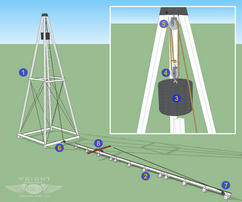
The Wright launching catapult consisted of a derrick (1) and a
launching rail (2). The derrick suspended a heavy weight (3) about
20 feet (6 meters) above the ground. A rope ran from a simple pulley
(4) at the top of the weight through a compound pulley (5) at the
top of the derrick, then down through the simple pulley and back up
through the compound pulley. From there it ran down to a simple
pulley (6) at the bottom of the derrick, then under the rail to
another simple pulley (7) about 65-75 feet (20-23 meters) out along
the rail. From the rail pulley, it ran back to a tow bar and hook at the front of the
airplane (not shown). The airplane rested on a two-wheel truck (8)
which rested on the rail. When the weight dropped, the rope pulled
the airplane and the truck along the rail. As the airplane took off,
the rope slipped off the tow bar hook and the truck ran off the rail end.
For more information about the Wright catapult, including an
interactive 3D illustration,
click HERE.
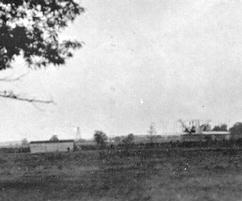
This is the only photo of the Wright catapult taken
in its first year of operation. It shows the first seconds of Flight No. 69
on 14 October 1904 The derrick is visible just to the right of the shed.
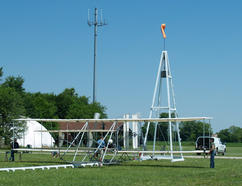
Our working replica of the Wright's catapult at Dahio Airport (I44) near
Dayton, Ohio. The aircraft on the launch rail is a
1905 Wright Flyer III replica.
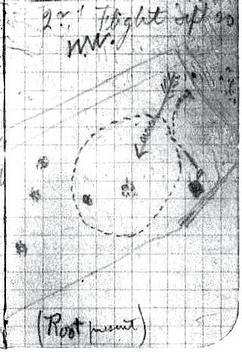
Wilbur made his sketch in his notebook showing the
path of Orville's flight on 20 September 1904 -- the first flight in a
complete circle.
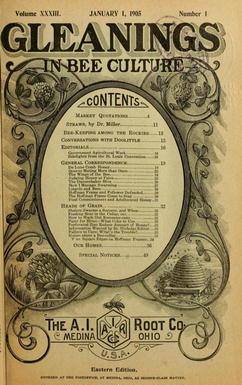
Amos Root, publisher of Gleanings
in Bee Culture, witnessed the 20 September flight and wrote
about it in his 1 January 1905 issue. You can read the full story
HERE.
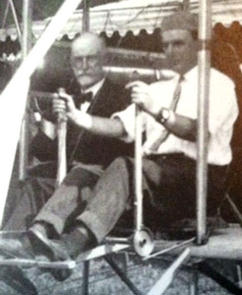
Amos Root (left) in the passenger seat of a Wright Model B at the
Medina Fairgrounds in 1912. Root remained friends with the brothers
and advised them on how to manage their patent.

Flight No. 82 on 9 November 1904 lasted five minutes and four
seconds as Wilbur made four rounds of the Prairie, covering over
three miles (4.8 kilometers).
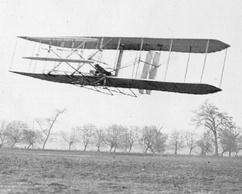
On 16 November 1904, the bothers made four flights (Nos. 84 through
87), landing each time with no damage to the machine.
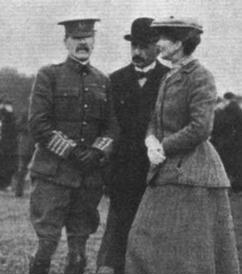
Lt. Colonel John E Capper (left) became head of the Royal Aircraft
Factory and oversaw the development of several important pioneer
aircraft.
|